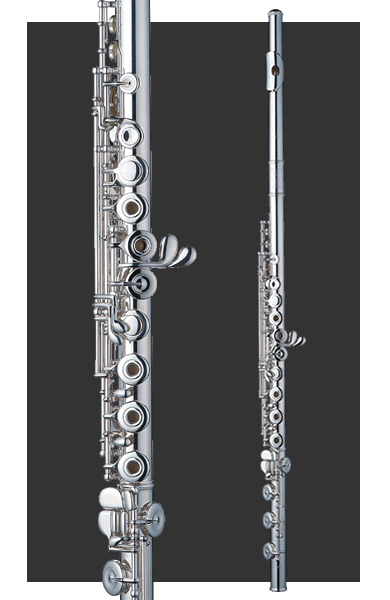The Sankyo-Kingma flute is the result of the collaboration between the Sankyo Company and Dutch flute maker Eva Kingma.The Sankyo-Kingma flute is a complete gBoehm systemh flute that can be played by anyone familiar with such an instrument. The Sankyo-Kingma flute offers, in addition to the Boehm system, six extra keys and a full key-on-key Kingma system.
The idea is basically this: why should we be hampered by the fact that human beings have fewer fingers than a flute has keys thereby limiting the number of open holes to only five? On a Sankyo-Kingma flute, eleven keys can be used as open-hole keys. In the first place, this gives superb pitch control as well as the ability to play complete chromatic quartertone scales in all registers; also traditionally difficult fortissimo notes are greatly improved.
Secondly, players of contemporary music, jazz, non-western music, as well as composers, are able to make use of the (chromatic) multi-phonics which are missing on the traditional flute.
The Sankyo-Kingma flute is not only a good starting point, but also a gnew approachh to flute playing.
The unique feature of this instrument is that there are six extra keys in addition to the standard Boehm mechanism. These keys are operated by the patented key-on-key system, invented by Eva Kingma. They are used to produce six of the seven quarter tones and multi-phonic vents which are missing on the normal French model flute. The seventh missing quarter tone is achieved by using the
C# trill key together with the normal C key. The other five quarter tones are produced by using the normal open-hole keys.
For the uninitiated, the first and most important advantage of the system is the superb pitch control; usually players struggle to match intonation with other instruments. The traditional open-hole flute allows the flautist to adjust pitch on some notes by slightly opening or closing one of the five open-hole keys.
The Sankyo-Kingma flute extends this possibility in a logical fashion to those keys that are normally out of reach on a traditional instrument. Flautists can confidently play some of the difficult fff notes without going sharp. The flute also creates unique opportunities for the use of alternative fingerings.
For example, for a stable high F#, there are at least three alternative fingerings.
The pitch control of this instrument is invaluable when performing in diverse ensembles and differing musical genres.
The second significant advantage of this instrument enables the performer to play quarter tone scales in all registers, something which on a traditional flute could only be achieved by venting open holes and shading certain notes with the use of alternative fingerings. With this instrument, the flautist can play all the quarter steps from F# to G# and from Bb to D accurately; an attractive prospect for players of jazz and non-western music.
The third advantage of this instrument is its ability to produce unique multi-phonics. Due to the fact that all covered keys can be vented, it is possible to produce chromatic progressions of multi-phonics resulting in the marvellous compositional opportunities that are built into this flute. For example, it is possible to play triple stops, starting with fundamentals in the lower register and ascending chromatically as keys are vented sequentially. The practiced performer will be able to play both chromatic quarter-steps and multi-phonics as well as standard chromatic scales. These are important options for players of modern repertoire as well as composers who wish to write uncompromisingly for the flute.
Sankyo-Kingma flutes are made with an offset G key, a B foot joint and a C# trill key. Body tubing is available in three thicknesses of silver, 10k and 14k rose gold, 14k white gold, and platinum. The mechanism and keys are made of silver or Nickel Silver. The flutes may be pitched to A-440, A-442, A-444, or A-446.



